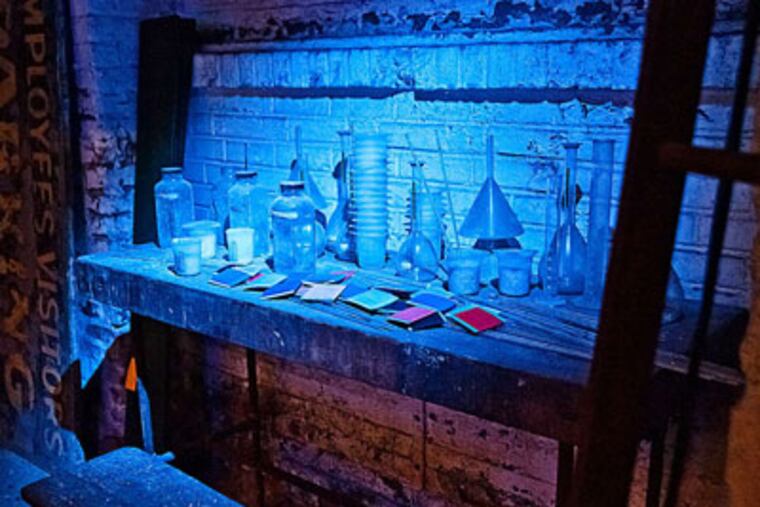Galleries: Globe Dye building is an atmospheric setting for art
Put art in it and they will come. That was the thinking behind Hidden City's festival of 2009, which drew Philadelphians into Girard College, the German Society, Disston Saw Works, and other historic structures they might never have entered otherwise. Now Philadelphia Sculptors, an artist-run organization of more than 250 sculptors, collectors, and art professionals, is counting on the Globe Dye Works in Frankford, a 19th-century relic of the textile industry, to exert a similar allure.

Put art in it and they will come. That was the thinking behind Hidden City's festival of 2009, which drew Philadelphians into Girard College, the German Society, Disston Saw Works, and other historic structures they might never have entered otherwise. Now Philadelphia Sculptors, an artist-run organization of more than 250 sculptors, collectors, and art professionals, is counting on the Globe Dye Works in Frankford, a 19th-century relic of the textile industry, to exert a similar allure.
The Globe Dye Works doesn't disappoint, nor does "Catagenesis," a 17-artist exhibition organized by Cheryl Harper and Philadelphia Sculptors president Leslie Kaufman. But the building is so atmospheric it can sometimes trump the art, starting with a video on its history by Harper and Kaufman, filmed and edited by Ben Graeff, that is hard to tear yourself away from and that definitely should be seen before you proceed to the as-yet-unrestored areas of the building where most of the artists' site-specific works are located.
Various members of the Greenwood family, which owned and operated the business over five generations, were tracked down and interviewed, as are the building's current owners, who rent studio and office spaces here and plan a more extensive renovation once this show is over.
Carolyn Healy and John Phillips, a collaborative husband-and-wife team, are the best known of the artists in the exhibition and they also make the most of the building and its available artifacts (artists were encouraged to use historical objects on the premises) in their installation Indigo Hunting, which employs film, sound, and a naturally spooky site to near-perfection. Scott Pellnat's Low Tide or Dance of the Seven Veils, an installation of haunting, kinetic ships suspended from the ceiling, conjures the slave trade and pirates; history buffs will think of the transport of sumac and indigo to textile-dye factories in Philadelphia.
As appealing as some installations here are, they quickly reference other art. Elizabeth Mackie's elongated bridal dress and veil, suspended from the ceiling and projected with images of animals (a tradition at the Globe was to send off female workers about to be wed with a pig on a leash), made me think of Beverly Semmes' long, suspended gowns. Damian Yanessa's installation of mirrors and lights that transforms a low-ceilinged space into a corridor of infinite depth and length recalls Lucas Samaras' mirrored rooms.
I enjoyed Joseph Leroux's The Thief and the Lunatic, with its floor of cut-up signs and assemblage of hexagonal speaker cabinets, because it attempts to meld with the building's infrastructure while maintaining its own surreal personality - an effect heightened by the artist playing his handmade harp. The same goes for Reece Terris' subtle rejiggering of the metal letters atop the factory from "Globe Dye Works" to Good-Bye Work."
"Catagenesis" also features works by Nivi Alroy, Christine Altman, Pam Bowman, Gandalf Gavan, Ryan Mandell, Timothy McMurray and Jacqueline Weaver, David Meyer, Michael Morgan, and David Page.
Summing her up
A pioneering feminist performance and conceptual artist of the early 1970s, Martha Wilson seemingly gave up her brilliant career when she founded Franklin Furnace in 1976 to collect and support the production of artists' books and periodicals. As the TriBeCa-based nonprofit's director, she also curated exhibitions of installation art and performance art for the next three decades. (Franklin Furnace Archive Inc. is now a "virtual institution" that uses its website, www.franklinfurnace.org, as its public face.) Still, Wilson's occasional satirical performances as Nancy Reagan, Barbara Bush, and Tipper Gore hinted at a future re-engagement with her art.
Sure enough, she is suddenly everywhere. She's joined the ranks of the pedigreed New York gallery PPOW, where she had a solo show of early and recent staged photographs in 2011. Since last year, she also has been the subject of Martha Wilson: Staging the Self, a traveling show curated by Peter Dykhuis with Independent Curators International (ICI) that is now at Arcadia University Art Gallery.
Wilson's place in the art firmament has never been easy to assess, but this retrospective look at her work as an artist and an advocate for others' avant-garde efforts argues that the two constitute a whole career in art.
It also makes the point that Wilson began creating her early photographs and videos of herself - making facial expressions of moods for the camera and posing as various female and male characters well before Cindy Sherman started her role-playing - while living far from the mainstream art world in Halifax, where she was teaching at the Nova Scotia College of Art and Design. (She was born in Philadelphia in 1947 and graduated from the George School.)
To create his whole, Dykhuis proposed that he show Wilson's early Halifax-based work; films of her collaborative performances with the New York all-female punk group DISBAND; and videos of her impersonations of Ronald Reagan, George W. Bush, and AL Gore, alongside film and other documentation of 30 Franklin Furnace projects by various artists - one per year from 1976 through 2006 - of her choosing.
The result is a rich, multifaceted portrait of Wilson that finally makes sense of her art and her life: She's the consummate collaborator, even, when necessary, with herself.